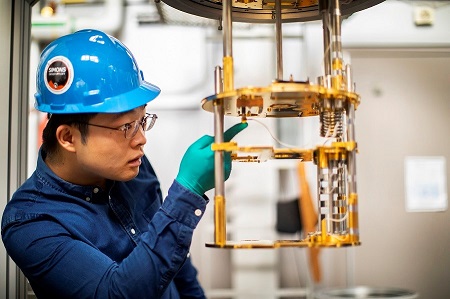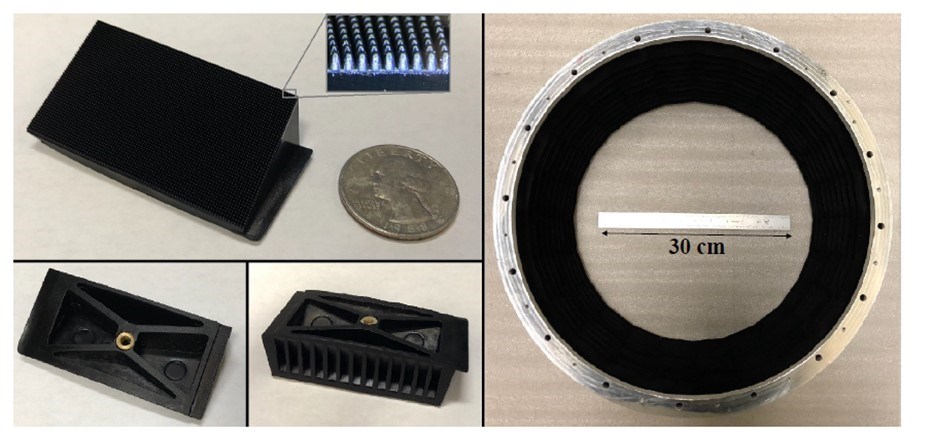Metamaterial tiles are poised to improve the sensitivity of telescopes currently under development at Simons Observatory in Chile. A multi-institutional team created the tiles, which have been incorporated into the receivers of telescopes that scientists at the observatory will deploy next year.
Work at the observatory aims to use an ultrasensitive millimeter-wave camera to capture measurements of the afterglow of the big bang with previously unattainable sensitivity, said Zhilei Xu, lead author on the research paper describing the tiles.
More broadly, Simons Observatory is the site of an effort to measure the cosmic microwave radiation (electromagnetic radiation in existence since an early stages of the universe) to improve understanding of the universe’s origins and evolution.
In testing, the metamaterial microwave tiles absorbed more than 99% of millimeter-wave radiation, while retaining their absorptive properties at the extremely low temperatures in which the millimeter-wave camera operates. The team used metamaterials due to the ability to engineer them to achieve very specific properties that do not occur in nature.

Thermal testing of the new metamaterial tiles in an advanced cryogenic facility showed that they could be effectively cooled to the cryogenic temperatures necessary. Courtesy of OSA, via Eric Sucar, Penn Today.
Doing so — developing a material capable of suppressing stray light while operating at extremely low temperatures — overcomes the results of previous attempts that involved materials that could either not be effectively cooled to cryogenic temperatures, or did not achieve the necessary combination of low reflectance and high absorption.
Other potential solutions have been difficult to install or produce in mass.
Xu, from the University of Pennsylvania, said that in application, the tiles will absorb environmental emissions that may obscure the signals that scientists at the observatory are attempting to measure. Ground-based millimeter-wave telescopes use receivers cooled to cryogenic temperatures to reduce noise and boost sensitivity. These highly sensitized receivers can be negatively affected by any amount of stray light — plaguing both the performance of the detector itself as well as the quality of the image it is capturing. Ensuring the ability to suppress stray light within the receivers themselves directly increases their sensitivity to very faint signals, while indirectly improving the accuracy of measurements scientists can collect using the imaging technology.
After complex electromagnetic simulation studies, the researchers selected metamaterials based on a material that combined carbon particles and plastic. Xu said that the team assembled the tiles by using injection molding of commercially available materials. This made them mass producible, easy to install, and cost effective.
The plastic composite exhibited high absorption in the desired microwave region of the electromagnetic spectrum, though the surface of the tiles reflected a significant amount of radiation before it could get inside the material to be absorbed. Adding an antireflective coating, which the researchers delivered using injection molding, reduced reflection.
“The low-reflectance surface combined with high-absorption bulk material allowed the metamaterial absorber tiles to deliver excellent suppression of unwanted signals at cryogenic temperatures close to absolute zero,” Xu said.

Researchers developed new metamaterial tiles that will improve the sensitivity of telescopes at the Simons Observatory by absorbing stray light. The top left photo shows one tile, with its antireflective surface shown in the inset. The bottom left photos show the back of the tile, and the photo on the right shows the assembly of 240 tiles installed on the wall of an optics tube. Courtesy of OSA, via Zhilei Xu, University of Pennsylvania.
The tiles successfully maintained their ability to perform through thermal cycles from room temperatures to cryogenic temperatures, as the researchers showed their effectiveness when cooled to −458 °F (−272 °C) and then measured their optical performance.
Measuring the performance of the tiles necessitated building a custom test facility. There, tests showed that the metamaterial exhibited excellent reflectance properties with low scattering (absorbing nearly all incoming photons).
“As detector sensitivity continues to improve for millimeter-wave telescopes, it becomes crucial to control scattered photons,” Xu said. “The successful combination of a metamaterial and injection molding manufacturing opens up many possibilities for millimeter-wave scientific instrument design.”
The research was published in Applied Optics (www.doi.org/10.1364/AO.411711).